
How to identify fake ancient coins
Do you want to know if a coin is genuine? I give you the keys in this article to know how to effectively spot a counterfeit coin. This article will be in several chapters, presenting and explaining in detail each technique. (if you do not know the numismatic terms like dies or other, click here: https://www.all-your-coins.com/en/blog/antique/romaines/comment-identifier-les-monnaies-romaines.)
Summary:
Introduction: the points to remember.
chapter 1: the diameter.
chapter 2: the weight.
chapter 3: the metal.
chapter 4: the style and quality of engraving.
chapter 5: the patina.
chapter 6: the surface.
chapter 7: the blank.
chapter 8: the edge.
chapter 9: the same coin in several copies.
chapter 10: missing details.
chapter 11: the same die.
chapter 12: the wear.
chapter 13: the hybrids.
chapter 14: the mold fakes.
chapter 15: the electrotypes.
chapter 16: the tooling.
chapter 17: the problem of the contemporary fakes.
chapter 18: the ancient fakes.
chapitre 19: the fake coins for tourist.
Conclusion.
Introduction: the points to remember.
First of all, some very important points that will allow you to take a big step right away: put yourself in the head of a forger. Why imitate, how and what are the constraints. One imitates a coin for three reasons:
- to fool a collector and win money.
- to create replicas of extremely rare coins and to be able to show them to the public.
- to sell them as fake to collectors who want to plug a hole in their collection (when a coin is very rare).
For the last two reasons, there is always one or more details showing you that a coin is a replica. Because the people who created these currencies are honest. They do not wish to deceive a collector. And most importantly, they do not want anyone, with one of their copies, to try to sell this one as a genuine coin. In this case the coin may have the mention "copy" on the slice or in the middle of the coin. As the little ''R'' on top left, indicate here: ''Replica'' on this coin:
.jpg?1572863877941)
Photo of a coin posted on forumnumismatique.com, link to the website and the topic: http://www.numismatique.com/forum/topic/28344-lettre-r-sur-une-monnaie-ancienne/?tab=comments#comment-141940.
The metal can be other than the authentic coins, we can also add or remove details ... or change the legend. For a connoisseur to make the difference right away. What are also called "fake tourists" are the easiest to detect: poor print quality, unusual weights and diameters ...
For fakes used to deceive the collector or the investor, two cases: rare coins and commons coins. The more rare the coin is, the more likely the buyer will be to have a minimum of knowledge and many specialists will see the sale, because it is the kind of coins they are looking for. In this case the work of the forger will be very well done. It will probably respect weight, diameter, style... He will try to make a copy as perfect as possible. On the other hand, it will inevitably use modern manufacturing techniques which will leave traces and will make it possible to know that it is a forgery (one will come there later in the article). Given the profit made if the coin is sold, the forger will take the time to work long on his replica. He will also have a substantial material and be able to recreate the conditions of a real antique mint. Heat the blank, engrave dies... I let you imagine. This is therefore for a very small category of counterfeiters. We are talking here about coin on sale at several thousand euros ...
The second case, that of the current coins, is more complex. Indeed, who says common coin says: low selling price. It will therefore be necessary to manufacture a quantity large enough for the activity to be profitable. And there, the problems begin for the forger. He wants to make money easily and spending as little time as possible ... he has also turned to common coins because we are less wary of a coin sold 30 Euros than a coin sold 2000 euros. Probably also because he does not have the ability to create a fake of excellent quality to sell it very expensive. His work will cause several things: for example, there will be 100 times the same coin with the same centering ... which is impossible. If you see two coins of the same type with the same centering: no doubt it is a modern fake. I will detail all this further down in the article.
Before looking at the chapters below, you must understand several more things. The, diameter, weight and patina, alone, are not elements allowing to eliminate a coin of the authentic category. Indeed, an authentic coin can have a large diameter or a heavy weight. And a patina may have been made on a authentic coin but that had been cleaned. The "repatinage" as they say, is common, to restore its antique appearance to the coin.
The fake antique coins, that is to say made in antiquity, also have a low weight, the diameter can be also. The quality of engraving will often be of very poor quality. To summarize, you can have a coin with a degenerate style, a weight and a small diameter, a metal other than that of the official coins, which is a fake antique. An imitation made on the same period. Of course, for metal, if you see a steel or tin coin, it is obvious that it is not antique.
Concerning errors and hybrids, as well as diameter and weight, this does not rank a coin in the category of modern fakes. A mistake of legend can happen during the engraving in an antique mint. Antique hybrids also exist. When we speak of hybrids, we designate an obverse and a reverse that should not be associated because of a different period. Example, an obverse mentioning that the emperor is consul for the third time and a reverse mentioning that he is consul for the fourth ... This is an example to show you that a hybrid combines two different periods. Modern counterfeit coins are sometimes hybrids because of a bad knowledge of antique numismatics from the forger. It can also be a desire of the engraver to create an original coin, so to sell it more expensive and to have fewer points of comparison available. The problem being that counterfeiters in antiquity also unwittingly created hybrids or their coins included legend errors. Why? Because many of them could not read, so it was difficult to copy the legends correctly. The other point and this can also be true for modern fakes: copy techniques. For example, when one practices the molding, it is common to mold several coin at the same time: one will thus take a mold presenting the obverse of a coin and a mold with the reverse of another. This creates the unlikely mixes that can be observed next.
That being said, perfect authentic coins coming out of an official mint, are sometimes hybrids, made by mistake by re-using an old die coin with a new one.
We must remain vigilant with all these parameters. If you are not used to seeing ancient coins, proceed as follows: Once you have identified the denomination (denarius, Antoninian etc.), the emperor or the region of strike, the period. Read the chapters of this tutorial and then compare your coin with others that are the same. I specify: same denomination, same legend (writings on the coin), same clothes, same type of reverses. Everything must match. I add in addition, the same mint. From one mint to another, the style of representation sometimes changes a lot. An emperor will have a large portrait with a small eye, and in a more distant mint he will be slim with a really big eye. This will prevent you from being disturbed by comparing coins.
Chapter 1: the diameter.
The diameter of an antique coin varies slightly, from one to two millimeters. Large diameter differences become suspicious. It is even possible for the diameter to become that of a lower or higher denomination for counterfeit coins. Even though real antique coins may have a larger diameter. We are talking about '' large blank ''.
An antique engraver create a die, it is the name given to the tool whose end is engraved in hollow and which prints the drawing in relief during the striking. We put a blank on one of the two dies and we come to crush the blank by hitting it with the second die of the top. The blank is printed on both sides. When engraving, we add small dots that create a circle surrounding the entire drawing. We call this the ''grenetis'' (french term). Therefore if the blank is wider than the drawing, we will see virgin metal outside the grenetis. You understand then that a coin whose blank would be wide with a sticky drawing at the edges would be abnormal. Of course, I'm talking about a really large blank ... The width of the drawing may vary slightly.
Once again, one must have the habit to being sure that the coin is fake if only this detail is unusual. On the other hand this detail added to others leaves no more doubts. Remember that if the diameter is really too small or too big, you can already study the track of a counterfeit coin. Look for example this fake modern whose design is very small compared to the size of the blank:
.jpg?1572892144872)
Photo of a coin posted on forumnumismatique.com, link to the website and the topic: http://www.numismatique.com/forum/topic/28430-monnaie-antique-inconnue/.
Chapter 2: the weight.
As for the diameter, the weight varies but there is an average for each denomination (even if in very rare cases, it happens that the currency is very heavy compared to the theoretical weight). A counterfeit currency will most often have a low weight. The metal used may not be the same as that of an antique coin, an alloy for example. Which explains that the weight will be different. If the metal used is the right one, the weight may be different because of the manufacturing methods.
Chapter 3: the metal.
Always look if it's the good metal. Modern fake denarius will not necessarily be in silver but for example in tin. Similarly for gold ... why invest in gold if you can make a gold plating or even use brass. Some are trying to sell 2000 euros a coin whose metal is worth 1 euro. Always compare a coin with others, if the color is not good there is a problem or it is a patina ... yes except that silver and gold will not change as much as bronze that can be black, green or brown. In addition, it joins the chapter about weight, if the metal used is different, the weight will not be the same.
Chapter 4: the style and quality of engraving.
A forger can do the engraving himself, in which case all kinds of work can bet met. From mediocre to almost perfect. In addition to the quality of the engraving, the style can come into play. We speak of a 'modern' style. This modern style is distinguished by fine details on small elements. For example a child, exclusively represented in a simplistic way on the ancient coins. This child on modern fake will have very well represented hair, a mouth or something else. While on the real coins of one is satisfied with a head, a torso, two arms and two legs. No hair, no clothes ... It's the same for the portrait of the emperor who can have a very worked hair. Of course, you have to be a bit used to seeing antique coins to make a difference. Let's look some examples below.
We will start with a very simple example. Some Roman emperors, called "usurpers" have struck very few coins and in a very archaic engraving quality.. In this case, when we see a coin with very good detail and quality representation, we can already conclude that our coin is very doubtful. Unless it is an exceptional strike ... Below we will see the first coin that is an authentic Antoninian of Regalianus and a second coin that is a modern fake.
.jpg?1572458871589)
Photo of an authentic anotninian of Regalianus sold by Classical Numismatic Group, link to the sale and their website: https://www.cngcoins.com/Coin.aspx?CoinID=240371.
.jpg?1572893021576)
Photo of a fake antoninian of Regalianus sold as modern fake by London Ancient Coins, link to the sale: https://www.acsearch.info/search.html?id=3221532, link to their website: https://www.vcoins.com/en/stores/london_ancient_coins-89/ancient-coins/Default.aspx?#!/Home.
No need to analyze the coin more thoroughly, we see immediately that this is a modern fake. The opposite case exists too. A counterfeit coin can have a low quality of representation compared to genuine coins. This happens often when the coin is cast from an original. The details do not print well and sometimes even, a part of the drawing disappears during the detachment of the coin from its mold. In this case the forger corrects himself and I let you imagine the quality of his work. Some counterfeiters have them, a true artistic talent and the quality of representation is excellent.
Let's move on to a coin of Faustina. Do not look at the changing bust orientation, just the engraving. Here, the modern coin displays a drapery whose style differs from that of genuine coins. In general, for the entire drawing, the details are deeper.
.jpg?1572893967377)
Photo of an authentic denarius of Faustina II sold by Numismatik Naumann, link to the sale: https://www.acsearch.info/search.html?id=2520121, link to their website: http://www.numismatik-naumann.at/.
.jpg?1572894027936)
Photo of a fake denarius of Faustina II sold as modern fake by London Ancient Coins, link to the sale: https://www.acsearch.info/search.html?id=3221500, link to their website: https://www.vcoins.com/en/stores/london_ancient_coins-89/ancient-coins/Default.aspx?#!/Home.
*WARNING: this chapter shows you coins that are easy to detect. Other coins will be more difficult to detect and will require advanced knowledge about antique numismatics. If you do not know anything about ancient coins, type the name of the emperor, the region, etc. on the internet and compare with the usual style. Attention, you must compare the same coins, therefore the exact portrait with the crown, the clothes, as well as the writings (which one names legend) and the drawing of the reverse must be the same as the writings ( except for mint marks). Indeed, several cases of figures can appear. The drawing is degenerate: it may be an antique imitation made by a forger in antiquity. The coin can also come from a local mint (very common for emperors in Gaul) where the engravers were less talented. In this case, we say "barbarian style" because the engravers were not from the empire.
Chapter 5: the patina.
One obvious thing: a modern counterfeit coin did not have time to have a patina (unless the coin is a fake old enough). You understand then that a forger must artificially give a patina to his currency to give it an antique appearance. Once again, you must be used to seeing real antique patinas to differentiate between the two. In addition, I now specify that an artificial patina is not always a proof that a coin is not ancient. For example, some authentic coins are cleaned with products to remove the patina and then, another person will try to restore its antique appearance by applying an artificial patina.
In this tutorial I will show two coins that are easy to analyze. Artificial patinas are often black and give a powdery appearance. In addition the highest reliefs are often very bright or clear while the edges of all the details are very black. In the example below, we see that around the letters, the field and the drawing, the patina is very dark. The field of the coin, that is to say the smooth, ungraved bottom, is clearer as we move away from the engraved elements.
Patinas too uniform are also common on fake coins. When one knows the normal patina of a coin having spent time buried, one immediately makes the difference with a worked patina. In addition, the coins we saw are supposed to be in silver .. without looking at how the patina is deposited, we understand that these black traces should not be there on money ...
.jpg?1572894750772)
Photo of a fake didrachm of Velia Here is an example of the effect produced London Ancient Coins, link to the sale: https://www.acsearch.info/search.html?id=3221399, link to their website: https://www.vcoins.com/en/stores/london_ancient_coins-89/ancient-coins/Default.aspx?#!/Home.
It is obvious that this patina is false and that it is a deposit made by the forger, the black and uniform area around the drawing of the two sides leaves no doubt.
Another more glaring example:
.jpg?1572894871629)
Photo of a fake denarius of Aquilia Severa sold as modern fake by London Ancient Coins, link to the sale: https://www.acsearch.info/search.html?id=3221520, link to their website: https://www.vcoins.com/en/stores/london_ancient_coins-89/ancient-coins/Default.aspx?#!/Home.
Chapter 6: the surface.
Depending on the manufacturing methods, traces can be seen on the blank. I had already explained to you at the beginning of the article, that a large blank coupled to a drawing going to the edge was abnormal. What else to analyze?
The luster: ancient manufacturing techniques occasioned what is known as the ''radiations'': that we see particularly on silver coins. These are fine lines that radiate and are only obtained under certain conditions. Conditions that counterfeiters can not reproduce. If you see a coin with these lines, it's a very good sign. On the other hand, their absence does not necessarily justify classifying a coin as "modern fake", but questions. Indeed, a heavily cleaned coin will have removed these lines. Moreover, on photo, it is difficult to make these lines appear.
.jpg?1572895310912)
Photo of a denarius sold by iNumis, link to the sale: https://www.acsearch.info/search.html?id=2670045, link to their website: https://www.inumis.com/.
Zoom:
.%5B1%5D.jpg?1572463119934)
A granular surface: this may indicate that the coin has been created by a spark erosion matrix. The small details will also disappear because of this technique. A poor quality mold can also give this kind of surface. However, an authentic coin will sometimes have a granular surface because of the conditions of conservation of the coin. But we see the difference between a coin whose surface is destroyed and becomes granular and fake coin not destroyed.
.%5B1%5D.jpg?1572895999717)
Photo of a fake sestertius posted on forumnumismatique.com, link to the website and the topic: http://www.numismatique.com/forum/topic/28986-identification-monnaieromainemerci/.
Bubbles: when a coin is molded there can be bubbles, so we find them on the surface of the coin, which indicates that the coin has not been minted. Be careful, some ancient coins were molded ... sometimes you have to be careful. That being said, the full chapter on molded coins will give you the keys to differentiate a counterfeit coin.
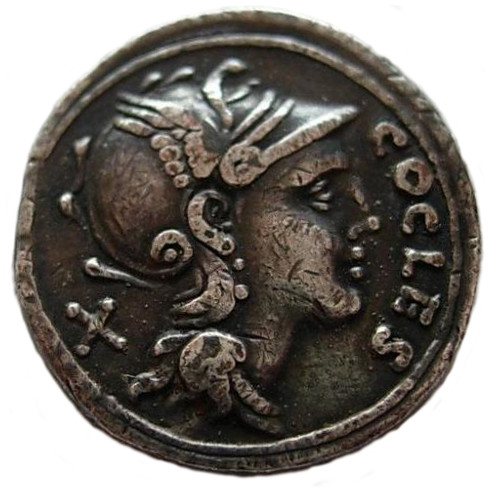
Photo of a fake denarius posted on forumnumismatique.com, link to the website and the topic: http://www.numismatique.com/forum/topic/27767-denier/. We see those bubbles around the portraiture.
Relief lines: another detail from molded coins. These lines in relief are the result of two things. The first being a smudge of metal created during the detachment of the coin from its mold. The second is the molding of a deep scratch on the original coin. A blow can also cause a ball in relief etc. The forger will sometimes try to smooth these imperfections in relief, which will also leave traces.
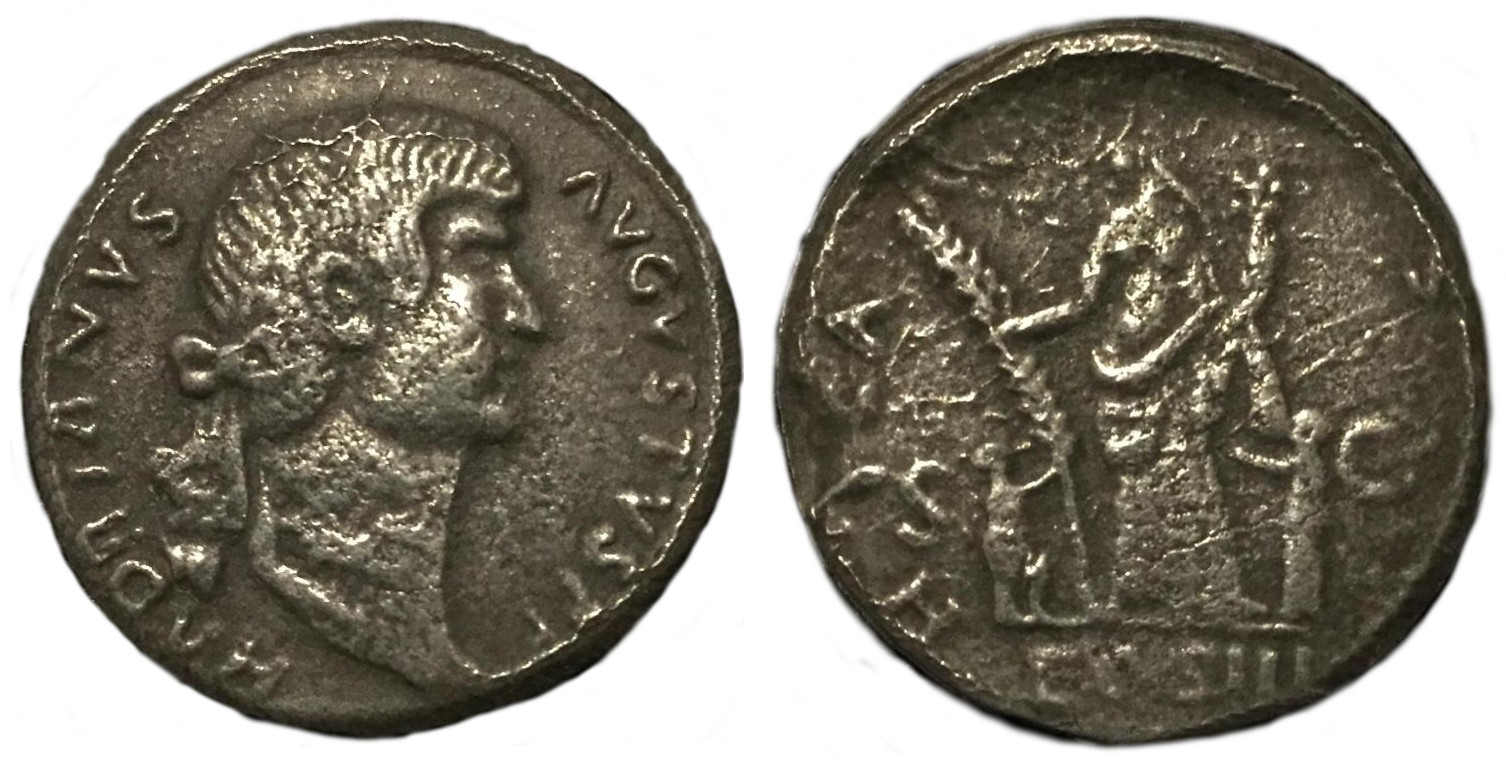
Photo of a fake denarius of Hadrian posted on forumnumismatique.com, link to the website and the topic: http://www.numismatique.com/forum/topic/27186-monnaie-romaine-%C3%A0-identifier/. In addition to the lines, we see a big run under the ribbon.
Too smooth: this kind of surface is the one found on modern coins. This is an indication that the coin is not antique.
For other surfaces, we will see them in the chapter on molds fakes.
Chapitre 7: the blank.
A blank that is too round and even perfectly round does not exist in antiquity. You will find irregular, oval blanks etc ... but never perfectly round. Only a machine can give a perfectly round blank. A fake modern will sometimes have this type of blank and this will allow you to have no doubt. The same applies to a very smooth surface of the blank (see the chapter on surfaces).
Chapter 8: the edge.
When a coin is cast, it will leave a furrow in relief that is the space between the two molds. Either the forger leaves it and we see it, or he files it and we see it too. He has no possibility of copying an authentic edge. Electrotypes have a similar and even bigger problem. Indeed, the forger must stick his two parts to create a two-sided coin. A seal is present between the two and therefore clearly visible. As for the molds, if he tries to hide this seal, we'll see it.
.%5B1%5D.jpg?1572474130127)
Photo of a fake mold coin, posted on forumnumismatique.com, link ot the website and the topic: http://www.numismatique.com/forum/topic/23876-monnaie-argent-grecque-4/?tab=comments#comment-118563.
For the rest and more details, everything is in the edge section of the molded coins chapter.
Chapter 9: the same coin in several copies.
With manufacturing techniques in antiquity, finding the same coin twice is impossible. I specify: when I say twice the same coin I speak about the same type, same dies (exactly the same drawing if you prefer), same centering, same form of blank.
Remember to check other available copies to see if they are different. Indeed, some fake coins, so well made, were detected only because that a second completely similar copy appeared later. Especially when we judge a coin on photo, weight and diameter ... if the weight and diameter are good, metal, engraving, style too, etc ... if we can not see the edge for example . How to do? This technique will be one of those we will use. I have already said in a previous chapter, that a forger, if he wants to create several different coins, will have to work enormously and especially to have a consequent material, to reproduce the ancient conditions.
In this chapter, I will approach a particular point. This requires a very good knowledge of ancient coins. An engraver did not work more than 20 years on average .. each engraver has a style of his own. So seeing two coins from the same engraver but with very distant dates tells us that the coin is a counterfeit.
Chapter 10: missing details.
Some copy techniques will make only details to appear, are hidden on the final result. Example with letters or a missing dots around the legend while no trace of wear is visible. Be careful when the dies are blocked, a piece of metal got stuck during the striking and blocked a letter or other small item. How to make the difference? It's simple, if you copy a offcentered coin, it will have for example the top of the legend that is missing and its dots around too. if you see a coin with these details missing while the blank perfectly leaves room to print these details: it's a fake.
Look the photo below (from a counterfeit coin which I have modified the reverse to give you the best example of what we see):
.jpg?1572896268903)
Photo from a coin sold as modern fake by London ancient Coins, link to the sale: https://www.acsearch.info/search.html?id=3221500, link to their website: https://www.vcoins.com/en/stores/london_ancient_coins-89/ancient-coins/Default.aspx?#!/Home. We often see this kind of missing detail (here on top left) because the real coin was offset or the blank is broken. Therefore we see a smooth part on the fake coin.
Chapter 11: the same die.
We know that a die is unique and its drawing too. If we find two coins or maybe four with the same die, either the issue was very short and the coin is very rare, or we searched for these specimens a very long time. Find coins sharing one or even two dies is rare ... So remember this: if we see too many times the same die spend in sales: there is a very high probability that it is a modern fake. Example, you look at a list of sales in recent years and find that 10 coins share the same die, it is very very doubtful. A die broke quickly and if we take into account the survival rate of a coin and other parameters that I wont list here, it greatly reduces the probability of finding today, two coins with the same die.
Chapter 12: the wear.
Here is a point we almost never talk about. Indeed, the wear must be reproduced by the forger. If he creates a fake from an authentic coin, the wear will be visible but will have a different look on his counterfeit coin. With a magnifying glass, we will see that the surface is too smooth on the ''worn'' parts, that no scratch is visible etc ... this kind of thing shows that it is not a true wear. The forger may have also filed down the desired parts. This will leave a special and visible trace. In addition, it is the high points that wear out first. High points are the most prominent parts. The most exposed parts on the portrait side are: the crown, the hair and the face. The crown when present, is the highest point. So a perfect crown with worn hair is not normal.
This seen, we must still imagine that a coin is not always flat when it experienced wear. We often see a worn drapery without the hair being touched. You will just have to think about the logic of the wear position compared to the rest. As for the example of the perfect crown whose hairs near are worn. This is the same area, so everything should have been exposed in the same way. Be careful though to the shots. For example, do not confuse a pick of the detectorist who found the coin, with wear. This blow can be anywhere on the coin.
To finish I strongly urge you to read the chapter on the tooled coinsg as this touches on the problem of the wear and can deceive you. A real antique coinage to improve its appearance will show you an illogical wear, with perfect hair and a striped and worn field. In reality, these hair is a modern engraving, they were work at the beginning, before someone engrave its twice.
Chapter 13: the hybrids.
If you have not read the introduction, go right now .. I will just summarize here what I already said in the introduction. So, we have seen that coins made in official mints, can be hybrids in the case of a reuse of an old die for example. The ancient counterfeiters also made hybrid coins, except that their coins were intended to make a profit, so the metal was filled (therefore a bronze blank was covered with a silver foil by example) or it was an alloy. Not to mention the barbaric style we see regularly. These antique fakes could associate for example an obverse and a reverse side of more than 30 years .. especially according to the region of origin of the forger. The coins of many emperors continued for a long time to circulate, especially outside the empire.
Conclusion, a hybrid with dies whose two years of manufacture are very far apart, if it is not a ancient fake, is a modern fake coin. If your knowledge is limited, be careful not to confuse a antique fake well done with a modern fake.
Chapter 14: the mold fakes.
We have seen in the chapter on surfaces, that a molded coin will make appear in relief, hollow elements on the original coin and that bubbles can be seen on the surface. But let us see in detail all that gives the possibility to recognize a molded coin. Attention, all these elements are not necessarily present at the same time.
Bubbles: air bubbles trapped during the casting (see the chapter on the surface).
The relief lines: deep and hollow scratches on the original coin and which are molded in relief. Or smudges during the detachment of the mold.(see the chapter on the surface).
The edge: if you see a relief line or part of that line on the edge: this coin has been molded. Indeed it is the separation between the mold above and the one below that creates this line, the cast metal being placed there. It will be seen below that this line is often filed down, so that says, edge filed says masking of the evidence. The chapter on the edge has already shown you this line resulting from the molding. Here is a edge filed as an example:
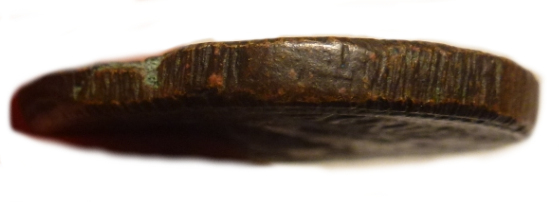
Photo of a coin posted on forumnumismatique.com, link to the website and the topic: http://www.numismatique.com/forum/topic/15876-help-vrai-ou-fausse-pi%C3%A8ce-romaine/?tab=comments#comment-77346.
Second case: the casting channel. If you mold several coins at the same time you can create channels between the molds so that by pouring at a single point, all the molds are filled. You will then have to cut these channels filled with metal to separate the coins. This gives a surplus of metal to a spot on the edge. Most of the time, these surpluses are filed and so as always, this is visible. Be careful though because in ancient times, for example with Gallic bronze, we used this technique, but we did not file the edge. Other ancient coins also came from this technique and even had the cut edge! CHECK THAT THESE TRACES ARE NOT NORMAL FOR THE TYPE OF COIN YOU ARE ANALYZING BEFORE YOU PRONOUNCE.
Partial cracks: to be precise, we are talking about cracks on the "model" coin which are found on the final mold but partly clogged. This crack on the real ancient coin being completely open, you find it on the obverse as on the reverse. On the molding, the coin will have two sides, a crack beginning with metal in the middle, as shown in the photo.
Here is an example of the effect produced:
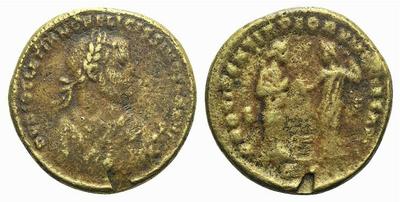
Photo of a coin sold as modern fake by London Ancient Coins, link to the sale: https://www.acsearch.info/search.html?id=3221536, link to their website: https://www.vcoins.com/en/stores/london_ancient_coins-89/ancient-coins/Default.aspx?#!/Home.
The aspect: First, a molded coin will never give as much detail as a minted coin. Now let's look at the different types of molds and the final result:
- clay and mold molds: which give a grainy appearance and I can tell you that the coins from these molds are very easy to recognize. Grains on the surface, missing details, low quality etc .. small precision, the Chinese, in antiquity, manufactured coins with these molds. Look at the picture below (coin already seen in the chapter about surfaces):
.%5B1%5D.jpg?1572481838834)
- Rubber molds: These often create round holes, visible on the surface. Like the bubbles we talked about in the chapter on surfaces, but here in hollow. The rubber traps the air and so, we see this kind of defect.
There are other types of molds. Without going into the technical details, we will just say that they offer a poor cooling technique, the end result is of a low quality with a bad printing.
Chapter 15: The electrotypes.
This chapter will be very fast. The two defects are: joint on the edge and plating problem. Electrotypes are almost nowadays because they require too much work and equipment. But many of them were created in the 19 th century. However they are very difficult to spot, the coins resulting from this technique offer a visual and a patina being almost the exact replica of an real coin. Except that the edge always has a joint trace, or, as on the molded coins, we have masked this joint and we it too! Always look at the slice of a coin.
Chapter 16: the tooling.
We see this more and more. Talented sellers take a worn coin and engrave twice themselves the hairs or any other part. In order to sell more expensive, a more beautiful currency to see. These coins are authentic and it happens that completely missing details are completely regraved. It is also done on the fake coins to give more details or to try to create to believe that the currency was struck and not molded.
I reassure you right away, it is very simple to see if a coin has been tooled (engraved twice). Already the quality of the drawing will probably be of a style different from that of the authentic remains. In addition, the engraving will always be deeper. As for the false wear, you will also see abnormally parts in relief while what is one millimeter near is completely worn.
To finish, the most obvious thing. When a part is worn, it is because, by friction or by blow, metal is gone. So when we engrave twice, we do it on a less prominent part. So there are problems with drawing depth. Let's still imagine this famous pick of the detectorist that I evoked in the chapter on usury. This blow will have removed the head of the character on the reverse. If you engrave on this hollow, you will have a particular result. The body will be more prominent than the head ... We sometimes see on some coins craters with a drawing appearing in the middle, so much the hole was deep.
Turning now to lettering, which, in addition to having the same defects as those already mentioned, will have one more. The tools used for engraving in antiquity (among the Romans) gave a particular form to letters. On the authentic coins, we see horizontal pointed lines at the ends of the letters. The letter A will show you both legs with this "sharp" line at the bottom of each leg. As in this picture. Of course, I try to summarize the particularity of Roman lettering, these elements may not be present or have disappeared. You have to know the Roman coins to see a wrong lettering.
Here is a coin very well tooled:
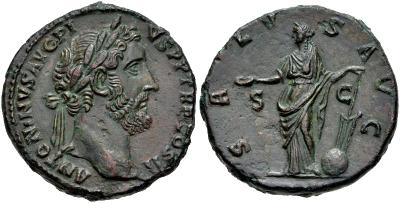
Photo of a coin sold by Classical Numismatic Group, who explain that this coin has been tooled, link to the sale: https://www.acsearch.info/search.html?id=5430114, link to their website: https://www.cngcoins.com/. Here there is no difference in wear, the coin was already very well preserved at the origin. The tooling is here to improve the visual. The engraving is too deep compared to a normal coin, the drapery of the character on the reverse is too much detailed too. This work is however of a great quality, let's see what we are used to seeing as work:
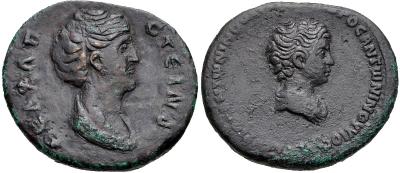
Photo of a coin sold by Classical Numismatic Group, who explain that this coin has been tooled, link to the sale: https://www.acsearch.info/search.html?id=1033623, link to their website: https://www.cngcoins.com/. The face is crude, the veil merges with the hair .. re-engraving much easier to identify.
Chapter 17: the problem of the contemporary fakes.
In antiquity, counterfeiters molded official coins, or created dies themselves. Being mostly illiterate or not knowing the language of the coin they imitated; this produced many errors. Delirious legends no longer resembling anything. Mixtures of letters from two different languages (example, Greek and Latin). But also, because of their weak skills, a poor style of engraving, hybrids of dies created with 30 years of difference ... Errors of representation etc ... Let's also count, that the only goal of the counterfeiter of the time is to earn a little money by exchanging a coin in a metal other than that of an official coin. For example, a denarius, so a coin normally in silver, which would be in fact bronze covered with silver (coin filled). Or an alloy. He can also try to create coins with a smaller diameter and thickness. Pay attention to the so-called ''sauce" coins, real Roman coins that were dipped in a bath of silver.This allowed the Romans to overcome the scarcity of silver. Of course, these have an excellent style and differ from the imitations .
Even if some ancient imitations are very well done, we will always see a style a little different from the official coins and especially a lower weight.
So, how do you differentiate a modern fake from an ancient fake because they share some similarities like weight or molding for example? It takes a minimum of knowledge to immediately recognize a ancient fake coin. But you can already help yourself with this: most counterfeiters will create a coin all the same closer to an official coin, otherwise they will make a small profit since the majority of collectors will believe that it is ancient imitation. But the best is that a ancient fake circulated, unlike the modern fake that will try to create an artificial wear. The metals used by modern counterfeiters, such as tin, do not exist in antiquity. With this, you have some basics. That said, when the weight is low, the style a little unusual etc ... a lot of collectors with a medium level of knowledge, think that a modern fake is an ncient imitative coin.
Fortunately, an ancient fake is sold between 5 and 50 euros (50 euros for an exceptional coin, whose engraving and quality justify the price because they are out of the ordinary). Therefore if you have trouble differentiating the two, I give you the technique: more than 30 Euros for a coin with a look of ancient imitation = do not buy. In any case, if it was a true ancient imitation, the price was somewhat excessive. The average price of an ordinary ancient fake is between 10 and 15 euros maximum and even under 10 Euros.
chapter 18: the ancient fakes.
Beware, the term old fake is used for antique coins created by counterfeiters in antiquity and also for fake more modern as those of the 19th century. I speak in this chapter of non-ancient fake coins. Some coins are old fake, made for prestige and not to deceive collectors. These fakes are known and made by prestigious engravers such as Becker or Giovanni Da Cavino. They are called Paduans. Here is one of them:
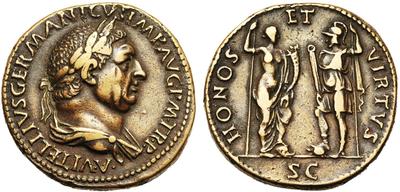
Photo of a padouan sold by Jean Elsen & ses Fils S.A., link to the sale: https://www.acsearch.info/search.html?id=4120279, link to their website: http://www.elsen.eu/.
These coins have real value. If you do not know the Paduans, you will confuse them with a modern fake. They have the same defects: perfect centering, unusual metals, modern style, hybrids etc ... For metal, this is apart. Most Padauans use good metals. To learn a little more about the subject, know that Becker was a proponent of aureus (so theoretically in gold) in tin. Sometimes even with a Roman obverse and a Byzantine reverse. Like this coin:
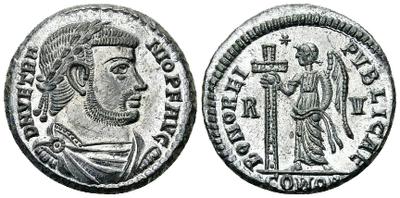
Photo of fake tin aureus by Becker sold by Auctiones GmbH, link to the sale: https://www.acsearch.info/search.html?id=3173953, link to their website: https://www.auctiones.ch/.
Chapter 19: the fake coins for tourists.
As they are created only for remembrance, they are ugly, molded, of very low quality, often do not respect the diameter or the weight and are in unusual metals. This allows them not to be confused with real coins. But still, those who have no basis on the subject are trapped and buy a fake for tourist 10 times the price at which the seller paid for it. Here is an example of what a fake tourist looks like:
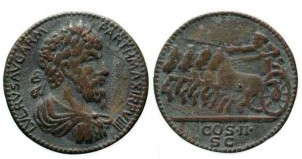
Photo of a coin posted on forumancientcoins, link to the forum and the topic: https://www.forumancientcoins.com/fakes/displayimage.php?album=42&pos=1179.
Conclusion
With this tutorial you have largely enough to progress and check if a coin is a modern fake. I advise you to read the whole of the article that is complete. Finally, I am giving you a list of points to look at first:
- the weight
- the diameter
- the metal
- the edge
- the surface
These are the first elements that a collector should always look at any purchase or identification.